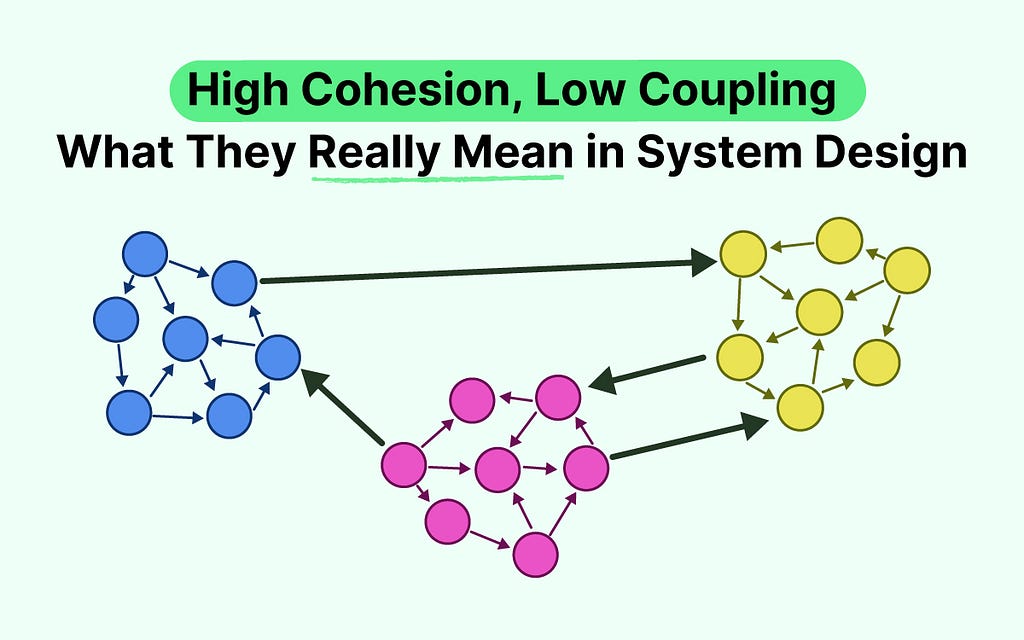This content originally appeared on Level Up Coding – Medium and was authored by Arslan Ahmad
High Cohesion, Low Coupling — What They Really Mean in System Design
A guide to coupling and cohesion in software design. Understand how these principles affect your code’s quality and learn strategies to design systems with flexible, modular architecture.

This blog demystifies coupling and cohesion — two fundamental principles in software architecture. You’ll learn what these terms really mean, how they impact the maintainability and scalability of systems, and get tips to design software with low coupling and high cohesion.
Have you ever fixed a “small” bug in one part of a codebase, only to see it break something in a completely different module?
Or added a quick feature and suddenly found yourself wading through a tangle of interdependent code?
If so, you’ve felt the pain of poor coupling and cohesion.
These two unseen forces often determine whether your software stays clean and flexible or turns into a nightmare of “spaghetti code.”
Most developers hear the mantra “high cohesion, loose coupling” as a hallmark of good design, but what do those terms actually mean in practice?
Let’s break it down.
What is Coupling?
Coupling is a measure of how much one component of a system relies on another.
In other words, it’s the degree of interdependence between modules.
Lower (looser) coupling is generally better because it means parts of the system can change with minimal impact on other parts.
If changing one module necessitates changing another, or if two components must be used together, they are tightly coupled.
By contrast, in a loosely coupled design, modules can function independently and interface with each other through stable, minimal APIs.
What is Cohesion?
Cohesion describes how closely all the pieces within a single module or component relate to each other.
It’s essentially about focus: a highly cohesive module has one well-defined responsibility or purpose, whereas a module with low cohesion does a little bit of everything.
High cohesion is desirable because when a module focuses on a single task or a group of related tasks, it tends to be more understandable, maintainable, and reusable.
Low cohesion, on the other hand, often leads to the dreaded “God object” — a class or service that tries to do too many unrelated things — resulting in confusing, hard-to-maintain code.
Grokking the System Design Interview | #1 System Design Course
Tips for Low Coupling and High Cohesion
So how can you achieve loose coupling and high cohesion in practice?
Here are a few tips and best practices:
- Group related functionality together: If two pieces of code serve the same feature or always change together, consider putting them in the same module or service. This naturally increases cohesion by keeping related tasks in one place.
- Separate unrelated responsibilities: Avoid the temptation to stuff every feature into one “god” component. If you find a module doing many unrelated things, refactor to split it by concern. Each module should have a clear, single purpose (think of the Single Responsibility Principle).
- Use clear interfaces between components: When modules need to interact, make them talk through a stable interface or API. Don’t let one module reach directly into the internals of another. By respecting boundaries (e.g. calling methods exposed by another class, or using REST/RPC calls between services), you reduce coupling.
- Minimize shared state: Global variables or a shared database schema used by multiple modules will couple those modules tightly. Encapsulate data whenever possible. For example, instead of multiple services writing to the same database tables, give each service its own tables or microservice datastore and let others access data through an API.
- Design for independence: Try to design modules and services that can be developed, tested, and deployed in isolation. If you can pull out a component and work on it without having to assemble the entire system, you’ve likely achieved low coupling. High cohesion helps here too, because an independent unit with a focused job is easier to handle on its own.
By following these practices, you’ll find that your codebase becomes more modular.
New features will slot in without breaking existing ones, and debugging will be far less painful.
Conclusion
In a nutshell, loose coupling and high cohesion are the secret sauce of scalable, maintainable software architecture.
They might sound like buzzwords from a textbook, but as we’ve seen, they have very real effects on your day-to-day coding life.
A system with well-decoupled, cohesive components is easier to understand, less prone to bugs, and more adaptable to change.
This is especially crucial for large applications and team projects — and it’s a reason these concepts come up often in system design interviews and code reviews.
As you design your next project (or refactor an existing one), keep these questions in mind:
Are my modules focused on single, clear tasks?
Can I change one part of the system without a domino effect on others?
If you can answer yes, you’re on the right track toward a clean architecture.
Further learning: If you’re preparing for system design interviews or want to deepen your understanding of software architecture, consider checking out DesignGurus.io’s courses like Grokking System Design Fundamentals, Grokking the System Design Interview, and Grokking the Advanced System Design Interview.
High Cohesion, Low Coupling — What They Really Mean in System Design was originally published in Level Up Coding on Medium, where people are continuing the conversation by highlighting and responding to this story.
This content originally appeared on Level Up Coding – Medium and was authored by Arslan Ahmad